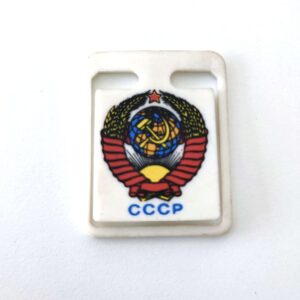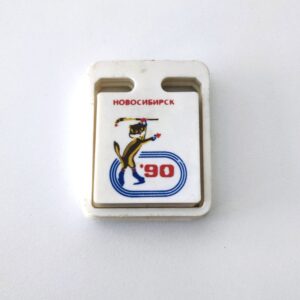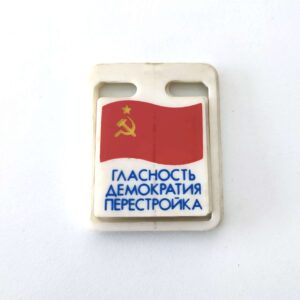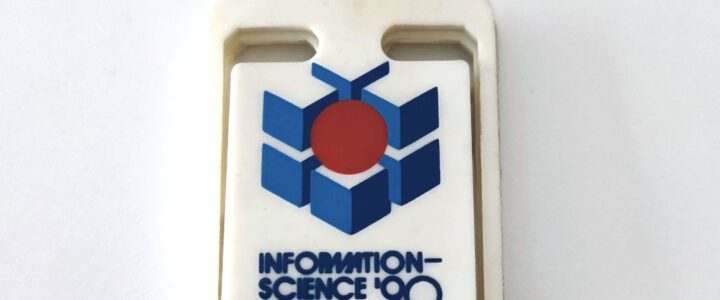Bookmarks are practical tools for keeping one’s place in a book, but they can also serve as historical artefacts, reflecting the values, reforms, and celebrations of an era. Soviet bookmarks from 1990, in particular, offer a fascinating glimpse into the culture and social dynamics of the Soviet Union during a period of great transition. Let’s explore some significant examples of these bookmarks, each with its own historical and cultural context.
Bookmark “Information-Science ’90” – Novosibirsk
This bookmark celebrates a conference related to information science held in Novosibirsk in 1990. The design includes a stylized blue cube with a red circle at the center, symbolizing the union of science and technology under the umbrella of Soviet innovation.
Historical References and Curiosities:
- Novosibirsk, located in Siberia, was one of the main scientific centers of the Soviet Union, with Akademgorodok (Science City) hosting numerous research institutes.
- The year 1990 marks a period of great transition for the Soviet Union, with glasnost (openness) and perestroika (restructuring) profoundly influencing society and science.
Details of the “Information-Science ’90” Conference: The “Information-Science ’90” conference was one of the most important events of the time in the field of information science. Organized in Novosibirsk, this conference aimed to bring together scientists, engineers, and researchers to discuss the latest innovations and future applications of information technology. The event covered various aspects, including:
- Information and Communication Technologies: The latest discoveries in computing, networking, and telecommunications were discussed. Participants explored how these technologies could be integrated into society to improve efficiency and productivity.
- Information Management Systems: Effective information management was a crucial theme, with sessions dedicated to new systems and software for data collection, processing, and storage.
- Cybersecurity: Given the growing importance of information networks, security measures to protect sensitive data and prevent cyber-attacks were also discussed.
Artificial Intelligence in 1990: Although the concept of artificial intelligence (AI) might seem modern, significant research was already being conducted in this field during the 1980s and 1990s. Soviet scholars were involved in various aspects of AI, including natural language processing, image recognition, and expert systems. However, it is important to note that discussions and research on AI were still in an early stage compared to today’s standards.

Bookmark with the Emblem of the USSR
This bookmark features the emblem of the Soviet Union, with the hammer and sickle, the red star, and the globe surrounded by ears of wheat.
Historical References and Curiosities:
- The hammer and sickle represent the union of agricultural and industrial workers.
- This emblem was one of the most recognizable symbols of the Soviet Union, used on official documents, flags, and coins.
- The acronym “CCCP” stands for the Union of Soviet Socialist Republics (USSR).

Bookmark with the Novosibirsk ’90 Mascot
This bookmark depicts a stylized mascot of Novosibirsk with the number ’90, clearly indicating a specific event or celebration for that year.
Historical References and Curiosities:
- Mascots were often used to promote sports, cultural, and scientific events, creating an emotional connection with the public.
- The year 1990 is significant as it precedes the collapse of the Soviet Union by one year, representing one of the last major events organized under the Soviet regime.

Bookmark “Glasnost Democracy Perestroika”
This bookmark is dedicated to the reforms of glasnost (openness), democracy, and perestroika (restructuring), introduced by Mikhail Gorbachev in the 1980s.
Historical References and Curiosities:
- Glasnost aimed to increase transparency in government institutions and reduce censorship.
- Perestroika represented an attempt to reform the Soviet economy and politics, moving towards greater openness and efficiency.
- These reforms were crucial in transforming Soviet society, ultimately leading to the dissolution of the USSR in 1991.

Conclusion
These bookmarks are not only useful tools for keeping one’s place in a book but also represent pieces of history, reflecting the values, reforms, and celebrations of a bygone era. Each offers an opportunity to better understand the Soviet Union’s final years and the transformations that led to its dissolution.
These items can be considered valuable historical artefacts, offering a tangible glimpse into the social and political dynamics of the late 20th century in one of the world’s former superpowers (История и современность) (VKevent) (РБК).



